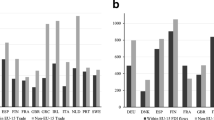Abstract
Writing in 2011, Paul De Grauwe noted the contrast between the alacrity of the ECB in providing liquidity in the banking crisis of 2008–09 and its reluctance to do so in the subsequent sovereign debt crisis:
Things were very different when the sovereign debt crisis erupted in 2010. This time the ECB was gripped by hesitation. A stop-and-go policy ensued in which it provided liquidity in the government bond markets at some moments and withdrew it at others. When the crisis hit Spain and Italy in July 2011, the ECB was compelled again to provide liquidity in the government bond markets. (De Grauwe, 2011a)
The ECB is ready to do whatever it takes to preserve the euro. And believe me, it will be enough. (Mario Draghi, July 2012)
Access this chapter
Tax calculation will be finalised at checkout
Purchases are for personal use only
Preview
Unable to display preview. Download preview PDF.
Similar content being viewed by others
References
Aizenman, J. and Hutchinson, M. (2012) “What is the Risk of European Sovereign Debt Defaults? Fiscal Space, CDS Spreads and Market Pricing of Risk,” European sovereign debt crisis Conference, Danmarks Nationalbank, April.
Barr, D., Bush, O. and Pienkowski, A. (2014) “GDP-Linked Bonds and Sovereign Default,” in Joseph E. Stiglitz and Daniel Heymann (eds), Life After Debt: The Origins and Resolutions of Debt Crisis, IEA Conference volume no. 152 (Basingstoke: Palgrave Macmillan).
United Nations (2012) Report of a Panel Discussion on “Facilitating International Adjustment through Timely Debt Resolution,” Tokyo, October 12 2012, organised by the Financing for Development Office, Department of Economic and Social Affairs, UN and Centre for Governance and Innovation, Canada. Available online at http://www.un.org/esa/ffd/msc/externaldebt/2012Pd_Tokyo/Report.pdf.
Buchheit, L. and Gulati, M. (2013) “Walking Back from Cyprus,” VoxEu, March. Available online at http://www.voxeu.org.
Bulow, J. and Rogoff, K. (1990) “Cleaning Up Third-World Debt Without Getting Taken To the Cleaners,” Journal of Economic Perspectives, vol. 4, no. 1, pp. 31–42.
Calvo, G. (1988) “Servicing the Public Debt: The Role of Expectations,” American Economic Review, vol. 78, no. 4, pp. 647–61.
Cohen, D. and Portes, R. (2004) “Towards a Lender of First Resort,” CEPR DP no. 4615.
De Grauwe, P. (2011a) “The European Central Bank: Lender of Last Resort,” Voxeu, August 18.
De Grauwe, P. (2011b) “The European Central Bank: Lender of Last Resort in the Government Bond Market?,” CESifo WP no. 3569.
De Grauwe, P. and Ji, Y. (2012) “Self-fulfilling Crisis in the Eurozone: an Empirical Test,” Conference on the European Sovereign Debt Crisis, Danmarks Nationalbank, April.
Draghi, M. (2012), Speech, July 26th. Available online at http://www.ecb.europa.eu/press/key/date/2012/html/sp120726.en.html.
Griffith-Jones, S. and Hertova, D. (2012) “Growth-Linked Securities,” in C. Fred Bergsten and C. Randall Henning (eds), Global Economics in Extraordinary Times: Essays in Honor of John Williamson (Washington, DC: Peter G. Peterson Institute for International Economics), pp. 123–42.
Krueger, A. (2001) “International Financial Architecture for 2002: A New Approach to Sovereign Debt Restructuring,” photocopy (Washington, DC: International Monetary Fund).
Leinemann, A. (2012) “Common Stability Bonds for Europe: A Game Theoretical Approach,” MSc dissertation University of Warwick.
Miller, M. (2011) “How the Euro Was Saved.” Available at http://www2.warwick.ac.uk/fac/soc/economics/staff/academic/miller/events/1129c_euro_bond_swap.pdf.
Miller, M. (2002) “Sovereign Debt Restructuring: New Articles, New Contracts — or No Change?,” International Economics Policy Briefs, PB02–3 (Washington, DC: Peterson Institute for International Economics).
Reinhart, C. and Rogoff, K. (2009), This Time is Different: Eight Centuries of Finanical Folly (Princeton, NJ: Princeton University Press).
Rogoff, K. (1999) “International Institutions for Reducing Global Financial Instability,” NBER Working Papers, 7265.
Simms, Brendan (2013) “One Nation under Brussels,” Prospect Magazine, August, pp. 5 4–7.
Steen, M. (2013) “Hearing Pits German Monetary Heavyweights Against Each Other,” Financial Times, June 9.
Editor information
Editors and Affiliations
Copyright information
© 2014 International Economic Association
About this chapter
Cite this chapter
Miller, M., Zhang, L. (2014). Saving the Euro: Self-fulfilling Crisis and the “Draghi Put”. In: Stiglitz, J.E., Heymann, D. (eds) Life After Debt. International Economic Association Series. Palgrave Macmillan, London. https://doi.org/10.1057/9781137411488_14
Download citation
DOI: https://doi.org/10.1057/9781137411488_14
Publisher Name: Palgrave Macmillan, London
Print ISBN: 978-1-137-41147-1
Online ISBN: 978-1-137-41148-8
eBook Packages: Palgrave Economics & Finance CollectionEconomics and Finance (R0)




